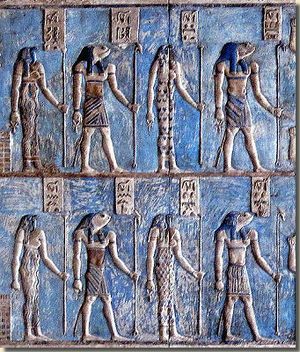اُگدواد

في الأساطير المصرية، اُگدواد (باليونانية قديمة: ὀγδοάς "the Eightfold"; Ancient Egyptian: ḫmnyw, a plural nisba of ḫmnw "eight") هو الاسم الذي عرف به ثامون هرموپوليس. رُتب الآلهة في ثامون هرموپوليس في أربعة أزواج من الذكور و الإناث هم: نون\نونة، آمون\آمونة، كوك\كوكة، حوح\حوحة، و فيه كانت الآلهة تمثل بضفادع و الآلهات بحيات. خلقت آلهة الثامون التل محتورت الذي ظهر فوقه الإله رع حسب رواية مدرسة هرموپوليس لأسطورة الخلق المصرية.
E. A. Wallis Budge (1904) compares the concept to a group of four pairs of primeval gods mentioned in the Babylonian Enûma Eliš, viz. Abzu and Tiamat, Lahmu and Lahamu, Anshar and Kishar, Anu and Nudimmud.[2]
Budge also argues that the Ogdoad is the original "company of gods" or pꜣwt nṯrw, represented by nine "axes" or "flagpoles" (the hieroglyph sign for "god",
| |
),arrived at by augmenting the original Ogdoad by the local chief deity of Heliopolis, Tem, by the authors of the theological system reflected في نصوص الأهرام.[3]
. . . . . . . . . . . . . . . . . . . . . . . . . . . . . . . . . . . . . . . . . . . . . . . . . . . . . . . . . . . . . . . . . . . . . . . . . . . . . . . . . . . . . . . . . . . . . . . . . . . . . . . . . . . . . . . . . . . . . . . . . . . . . . . . . . . . . . . . . . . . . . . . . . . . . . . . . . . . . . . . . . . . . . . .
الأسماء
الآلهة الثمان كانوا مرتبين في أربع أزواج ذكر-أنثى (أسماء الإناث هي مجرد الاشتقاق المؤنث لأسماء الذكور)، كما يلي:[4]
نو
|
ناونت
| |||||||||||||
ححو
|
ححوت
| |||||||||||||
ككوي
|
ككويت
| |||||||||||||
قـِرح
|
قـِرحت
|
The names of Nu and Naunet are written with the determiners for sky and water, and it seems clear that they represent the primordial waters.
The fourth pair appears with varying names; sometimes the name Qerḥ is replaced by Ni, Nenu, Nu, or Amun, and the name Qerḥet by Ennit, Nenuit, Nunu, Nit, or Amunet. The common meaning of qerḥ is "night", but the determinative (D41 for "to halt, stop, deny") also suggests the principle of inactivity or repose.[5]
الصفات
انظر أيضاً
المراجع
|
جزء من سلسلة مقالات عن |

|
|
المعتقدات الرئيسية
وثنية • وحدة الوجود • تعدد الآلهة |
| الشعائر |
| صيغة التقديم • الجنائز • المعابد |
| الآلهة |
| أمون • أمونت • أنوبيس • أنوكت أپپ • أپيس • آتن • أتوم باستت • بات • بس أبناء حورس الأربعة گب • هاپي • حتحور • حقت حورس • إيزيس • خپري • خنوم خونسو • كوك • معحص • ماعت معفدت • منحيت • مرت سگر مسخنت • مونتو • مين • مر-ور موت • نون • نيت • نخبت نفتيس • نوت • اوزيريس • پاخت پتاح • رع • رع-حوراختي • رشپ ساتيس • سخمت • سكر • سركت سوبك • سوپدو • ست • سشات • شو تاورت • تفنوت • تحوت واجت • واج-ور • وپواوت • وسرت |
| النـصـوص |
| عمدوعت • كتاب التنفس كتاب المغارات • كتاب الموتى كتاب الأرض • كتاب الأبواب كتاب العالم السفلي |
| غيرهم |
| الآتونية • لعنة الفراعنة |
- ^ "Drawn by Faucher-Gudin from a photograph by Béato. C.f. Lepsius, Denkm, iv.pl.66 c.", published in Maspero (1897). المشهد مدغم من "طرفي منظر عظيم في فيلة، يبدو فيه الثمانية، وقد انقسموا إلى مجموعتين من أربع، يشاركون في تمجيد الملك."
- ^ Budge (1902), p. 287f.
- ^ Budge 1904, p. 282.
- ^ Budge 1904, p. 283.
- ^ Budge 1904, p. 283-286.
ببليوگرافيا
- Baines, John D.; Shafer, Byron Esely; Silverman, David P.; Lesko, Leonard H. (1991), Religion in Ancient Egypt: Gods, Myths, and Personal Practice, Cornell University Press
- Budge, E.A. (1904), The Gods of the Egyptians: Or, Studies in Egyptian Mythology, 1, https://archive.org/stream/godsofegyptianso00budg
- Dunand, Françoise; Zivie-Coche, Christiane (2004), Gods and Men in Egypt: 3.000 BCE to 395 CE, Cornell University Press
- Hart, George (2005), The Routledge Dictionary Of Egyptian Gods And Goddesses, Routledge, p. 113
- Sethe, Kurt (1929), Amun und die acht Urgötter von Hermopolis
- Salmon, George (1887), "Ogdoad", in Smith, William; Wace, Henry, A Dictionary of Christian Biography, Literature, Sects and Doctrines, Volume IV, London: John Murray, https://books.google.com/books?id=e3DYAAAAMAAJ
وصلات خارجية
- Butler, Edward P. "Hermopolitan Ogdoad". Retrieved 2010-08-21.
